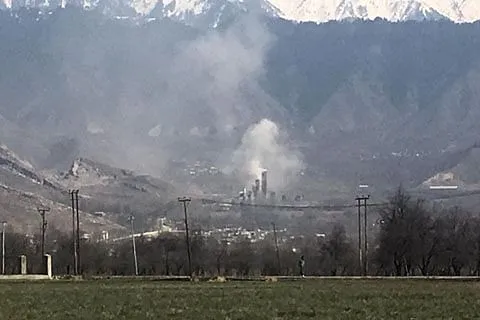Pollution caused by cement factories in Khrew area of South Kashmir is poorly or unsympathetically influencing saffron agronomy in general and production, productivity, and marketing in particular. Mercury component enormously affected its production and exaggerated the problems in the saffron industry.
It has affected its corm, bulb, stigma, and petals, and as a result, it generates very low production levels. Industrialization affects the well-being and welfare of human beings, flora, and fauna.
All those eco-friendly think tanks and scientists who have studied these effects in the saffron villages of Pampore in general and Khrew village, in particular, confirmed a very high positive correlation between industrialization and saffron deterioration.
Moreover, it confirmed that the presence of industries is very detrimental for the community on the whole in the short as well as in the long run.
The cement industry is one of the most important industries involved in air pollution and environmental degradation. The aerial release of cement factories is made up of particulate matter, Sulphur Dioxide and Nitrogen Oxides producing uninterrupted and noticeable clouds which at the end of the day settle down on the soil.
They have an emotional impact onentire biotic life all over the place, and as a consequence, the complete ecosystem from place to place around the cement factory is lay open to unexpected exploitation. The central pollution control board listed cement industry at 17th rank as far as best polluting industries are concerned.
Cement dirt holds substantial metals like chromium, nickel, cobalt, lead and mercury contaminations dangerous to the environs, particularly biotic environment with very high pollution elasticity of flora (Darley, 1996), fauna, human development, and ecosystem. This means a one unit change in the level of pollution caused by cement will bring more than one unit change in the flora, fauna, human development, and ecosystem respectively.
Globalization has a multidimensional impact on the process of industrialization in India. It led to the diversification and branching out of industries and skilled mobility on the one hand but the degraded environment on another hand.
It integrated the local design industry with the international design industry but at the cost of the environment. In fact, it streamlined, modernized, restructured, and updated the indigenous industries to satisfy entrepreneurs’ and factory owners’ expectations.
The entrepreneurs yearn for a peaceful future in which industry is recognized as being more innovative, ingenious, resourceful,and pioneering. But they should not neglect the environment for real peace is not in mere living but living well.
The industry stimulates wide-ranging responses to contemplations, designs, experiences, outlooks, and passions in a global village. Globalization has without any doubt made the graph of industrial growth upward but at the same time degraded the environment and affectedthe most popular view of sustainability or sustainable development.
In the globalized world, the cement industry is involved in the development of infrastructure for the reason that it kindles and supports economic growth but at the cost of nature. Furthermore, it is the elementary feature of resources used in erecting modern infrastructural networks and arrangements.
In fact, in this 21st century every Tom, Dick, and Harry cannot think without resources and their allocation for his growth and progress. Cement is a fine, ashen or snowy white powder which is fundamentally made up of Cement Kiln Dust (CKD), a by-product of the final cement product, typically put in storage as trashes in open-pits and landfills. It produces pollution and dust during its process of production.
When we expose ourselves to cement dust for a short span of time it is not problematic, conversely elongated experience can cause thoughtful irretrievable loss to flora and fauna.
Cement factories at the identical industrialized centers of Kashmir such as Khanmoh and Khrew release one lack kilograms of deadly smokes per day thus enfolding the nearby saffron villages in a toxic grey blanket.
Residents claim that these factories lack efficient pollution control instruments and therefore,insufficient to control pollution and destruct saffron industry.
In addition, they lack in-situ intensive care devices which are fixed in the factories so that we preventthe entry of the particulate matter into the atmosphere.Saffron (Crocus Sativus) plays a noteworthy role in the economy of Jammu and Kashmir.
It is the most expensive cash crop which needs protection from every end. According to Wani, Saraf & Wani (2008), more than 16,000 farm families of 226 villages are related with this crop directly or indirectly.It is very unfortunate that saffron is in shambles due to uncontrolled pollution caused by the cement factories around saffron growing belts of Pulwama district.
Conclusion:
It is high time for government involvement to make sure that all the eco-friendly laws related to the production of cement dirt in the country are strictly imposed. An externality in economics is the benefit or cost affecting a party who did not single out to incur that benefit or cost.
The cement factory creates both negative and positive externality and helps to spread rapidly the negative and positive outcomes for the society and environment.
The cement factories in the neighboring areas of saffron Karewas should realize that within their operational cost, the cost of the environment which originates from their negative externality is supposed to be internalized (Okojie., 2014). Furthermore, all cement factories must have a proper Environmental Impact Assessment.
ICSSR Doctoral Fellow, Department of Economics, CentralUniversity of Kashmir, Guest Faculty, NIFT, Srinagar.






